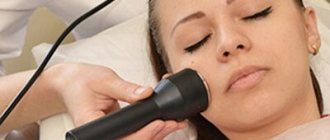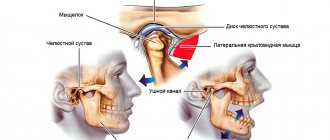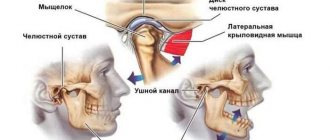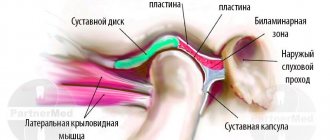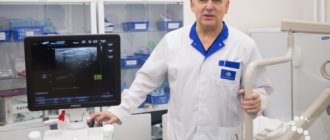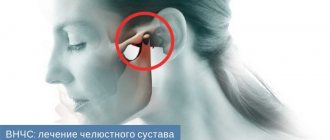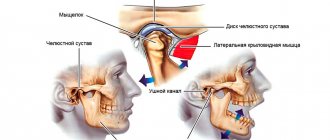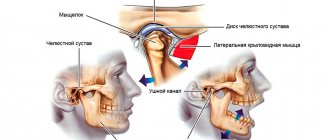Dental problems
Dental diseases
With deep caries and its complications - pulpitis, periodontitis - the pain radiates to the jaw in the area of the affected tooth.
Infectious and inflammatory processes of the soft tissues surrounding the tooth - periodontitis, abscess - cause swelling, which, by squeezing the nerve endings, provokes the appearance of painful sensations in the jaw.
With increased tooth sensitivity, eating hot, cold, spicy, sour or sweet foods and drinks, and brushing your teeth cause acute pain that spreads to the jaw.
When third premolars - wisdom teeth - emerge, complications often arise: pericoronitis, inflammation of the periosteum, one of the symptoms of which is severe pain in the jaw.
Dental treatment procedures associated with violation of tissue integrity - implantation, prosthetics, tooth extraction, installation of fillings, professional teeth cleaning and whitening - contribute to the appearance of pain in the jaw.
Bruxism
With bruxism, involuntary grinding of teeth at night significantly increases the load on the masticatory muscles, which leads to their prolonged spasm. In this case, the correct occlusion of the dentition is disrupted with the development of pain in the jaw when chewing.
Temporomandibular joint problems
If pain occurs in the jaw when opening the mouth, this is a symptom of temporomandibular joint pathology.
Pain in the projection of the jaw is often accompanied by pain in the ear, head, and face. The causes of joint dysfunction are injuries, malocclusions, incorrectly installed dentures, arthritis, arthrosis, and hypertonicity of the masticatory muscles.
Tumors of the lower jaw
Pain in the jaw area is characteristic of benign and malignant neoplasms. Benign tumors are characterized by slow growth and lack of invasion into adjacent tissues and organs.
Malignant neoplasia rapidly progresses, pain intensifies with irradiation into the eye, temporal region, ear, jaw.
How to get rid of unpleasant symptoms
The choice of method for eliminating pain depends on the cause that caused it. Do not self-medicate: warm, rinse or take pills without consulting a doctor. The insidiousness of pain syndrome is that it is characteristic of different diseases. In some cases, you can alleviate the condition before visiting a specialist.
Ear pain due to caries
You can relieve the pain a little with the help of anti-inflammatory tablets. In such cases, nimide or ibubrofen are recommended. The drugs should be taken after meals in the indicated dosages for no more than 5 days. Fans of traditional medicine use a natural antiseptic – garlic. It is crushed and applied to the diseased tooth.
What to do with pulpitis
The pain with this pathology is often unbearable. Therefore, patients with this disease usually strive to see a doctor as quickly as possible. Treatment can be carried out using biological and surgical methods. In the first case, the tooth is treated conservatively, in the second, the pulp is completely or partially removed. Once the cause is eliminated, the ear pain stops.
How to treat alveolitis
All treatment methods are aimed at eliminating inflammation in the socket. The process is stopped by taking anti-inflammatory, antibacterial and desensitizing agents. The treatment method is determined by the dentist after an x-ray.
Elimination of post-filling pain
The appearance of ear pain after installing a filling is a reason to remove it. The tooth is treated and filled again. In case of an allergy to the substance from which the filling is made, the doctor selects another material.
Pain after wisdom tooth removal
Damaged tissues and nerves need time to recover. Therefore, pain is a common reaction to intervention. To reduce it, dentists recommend taking painkillers. If the pain not only does not go away, but also intensifies, the doctor may prescribe antibiotics and recommend a special rinse.
Causes of jaw pain not related to dental disorders
Neuralgia
When the trigeminal nerve, which is responsible for the sensitivity of the face and oral cavity, is damaged, the pain is strong, sharp, reminiscent of the pain of pulpitis. Often patients with trigeminal neuralgia undergo unnecessary dental treatment with depulpation or tooth extraction, but the pain syndrome persists.
Sialolithiasis
Salivary stone disease is characterized by the formation of stones in the ducts of the large salivary glands. Since the salivary glands are located in the mouth, pain during their inflammation also affects other nearby organs of the oral cavity, in particular the jaw.
Sinusitis
When the mucous membrane of the maxillary cavity becomes inflamed, increasing swelling and accumulation of exudate cause pain spreading to the upper jaw area from the side of the affected sinus.
Otitis
Sometimes the symptoms of otitis media are similar to toothache. With inflammation of the middle ear, pain often radiates to the jaw. The pain is sharp, shooting, aggravated by chewing and swallowing.
Submandibular lymphadenopathy
Enlargement of the submandibular lymph nodes is observed in diseases of the tonsils, acute respiratory viral infections, stomatitis, and oncological tumors. Pain under the jaw is often accompanied by limited range of motion - it is difficult for the patient to bend and turn his head, or open his mouth wide.
Diseases of the cardiovascular system
Irradiation of pain into the lower jaw can be observed during an attack of angina and myocardial infarction. A characteristic symptom of coronary heart disease is burning, pressing pain behind the sternum. But with an atypical course of a heart attack, retrosternal pain may be completely absent, only reflected pain comes to the fore: in the left arm, in the neck, in the face, in the jaw.
Causes of pain
Painful sensations in the ear area and the right side of the head can occur due to inflammatory processes, as well as when the blood circulation in this area is impaired. The process can spread from the organ of hearing to part of the head and vice versa. When the first complaints appear, it is necessary to undergo an examination and determine their cause.
Otitis
Ear inflammation (otitis) can occur in adults and children. It occurs as a complication of viral diseases (ARVI, influenza), injuries, hypothermia or inflammation of the sinuses. At the first stage, the patient is bothered by constant pain in the ear, which spreads to the entire surface of the head. However, otitis media can progress and develop in several stages:
- aseptic inflammation, which causes aching pain;
- addition of a bacterial infection;
- development of purulent inflammation - accompanied by acute pain and hearing impairment;
- probable complications in the form of purulent melting of the eardrum, as well as the spread of infection to the inner ear and lining of the brain.
Otitis media is often chronic and appears annually. After an examination, an otolaryngologist will help you choose the most effective treatment regimen. It is important to pay attention to the first symptoms in time, since the chronic course of the inflammatory process can provoke partial or complete hearing loss.
Diseases of the external ear
The outer ear is the peripheral part of the hearing organ, which is separated from the middle part by the eardrum. Pathological processes in this area often manifest as acute pain in the right ear and head. With timely treatment, they resolve without complications, but in the absence of intervention they can spread to the middle and inner ear.
- Furunculosis, eczema, fungal skin infections - these processes are accompanied by inflammation and pain. The skin of the auricle turns red and peels, and ulcers (boils) may form on it. Treatment consists of external use of anti-inflammatory and antifungal drugs.
- Diseases that lead to the formation of cerumen plug - it forms deep in the ear canal, so it is impossible to remove it yourself. The cause may be anatomical features of the structure of the hearing organ or excessive formation of sulfur.
- Injuries, falls and bruises are another cause of inflammation of the outer ear. In young children, the process can be triggered by foreign objects entering the ear canal.
When diagnosing, it is important to assess the condition of the eardrum. Inflammatory processes can spread to it and even cause its perforation. Injuries that cause damage are also dangerous.
Inner ear diseases
Inflammation of the inner ear is the cause of acute pain in the right side of the head and in the ear. The organ has a complex structure and is responsible not only for hearing, but also for balance. It is presented in the form of channels and labyrinths filled with liquids. This is where bacteria multiply, causing inflammation.
Diseases of the inner ear require immediate treatment; in most cases, antibiotic therapy is used for this. The tympanic cavity is a comfortable environment for the growth of bacteria, and they can cause purulent inflammation. This leads to hearing loss, constant headaches, and the development of complications, including acute meningitis - inflammation of the membranes of the brain.
Change in blood pressure
An increase or decrease in blood pressure is a common reason why the right ear and the right side of the head hurt. Hypertension (high blood pressure) occurs due to insufficient elasticity of blood vessels, nervous tension and other factors. It manifests itself with characteristic symptoms:
- pressing headache that spreads to the back of the head, temple, and may affect the ear;
- deterioration of hearing and vision, the appearance of tinnitus;
- redness of the skin and mucous membranes, the appearance of small capillary hemorrhages.
With a decrease in pressure (hypotension), an increase in heart rate, weakness, and impaired coordination of movements are observed. The skin and mucous membranes may become pale. Insufficient oxygen supply to the brain is dangerous, as it can provoke a stroke or transistor ischemic attacks.
Stroke
Acute cerebrovascular accident is a stroke. It occurs when there is a sudden stop in the flow of oxygen-rich blood to certain areas of the brain. There are ischemic (manifested by blockage, compression of a vessel, low blood pressure) and hemorrhagic (the result of damage to an artery and hemorrhage in the brain) stroke. The first type is more common and is manifested by the following symptoms:
- sudden headache, often one-sided, which may affect the ear;
- impaired coordination of movements;
- weakening of the facial muscles on the injured side;
- discomfort and pain behind the sternum;
- impaired diction, the appearance of memory lapses;
- loss of consciousness.
The main reason why strokes occur is the lack of early diagnosis. Doctors at the Clinical Brain Institute recommend undergoing regular scheduled examinations to identify cardiovascular diseases in the early stages. Monitoring blood pressure, proper nutrition and dosed exercise, as well as systematically taking medications as needed are the basis for preventing stroke at any age.
Pain in the ear and right side of the head due to neuralgia
If your head hurts and radiates to your right ear, this may be a sign of neuralgia. This is not a separate disease, but a type of pain that occurs when a nerve is inflamed or damaged. The trigeminal nerve is most often affected, which gives off branches to the muscles of the face, the organ of hearing, the upper and lower jaws.
Neuritis is an inflammatory process that develops in nerve fibers. It is accompanied by acute throbbing pain, which can be one-sided, affecting part of the head, ear and half of the face. It intensifies with sharp sounds, bright lighting and other irritants, as well as with chewing and turning the head. Treatment consists of taking painkillers and anti-inflammatory drugs. If they are ineffective, a nerve block is indicated - injections along its course with anesthetics and hormonal anti-inflammatory drugs.
Diseases of the cervical spine
The cervical spine contains arteries that carry blood from the heart to the brain, analyzer organs, muscles and facial skin. Their mechanical pinching leads to impaired sensitivity in certain areas and chronic headaches. Normally, the vessels are located in the canals formed by the processes of the vertebrae, and blood moves freely through them. However, there are a number of diseases that lead to poor circulation, pain in the head and ear:
- osteochondrosis is a pathology of intervertebral discs, in which they become fragile and cannot absorb movement, and the distance between adjacent vertebrae decreases;
- spondylosis - fusion of two or more adjacent vertebrae as a result of injury, inflammatory or dystrophic changes, destruction of cartilage;
- curvature of the spine, most often cervical scoliosis;
- chondrocalcinosis - deposition of salts in the periarticular tissues, which leads to decreased joint mobility;
- intervertebral protrusions and hernias - protrusion of intervertebral discs, their gradual erasure until the outer fibrous membrane ruptures;
- vertebral displacement.
Spinal diseases often manifest as headaches. It can be one-sided, since the load on the spinal column becomes uneven, and mechanical compression of the vessels and nerves occurs.
Inflammation of the lymph nodes
Lymphadenitis is inflammation of the lymph nodes. Pain in the right ear and right side of the head can be caused by damage to the parotid lymph nodes. It is acute, pulsating, and may be accompanied by fever. The disease occurs as a complication of a viral infection of the upper respiratory tract; a bacterial or fungal pathogen can also be diagnosed.
With lymphadenitis, redness of the skin behind the ears and the appearance of a hard lump may be observed. The local temperature is increased and pulsation is felt. Treatment consists of taking antibiotics, anti-inflammatory drugs, and painkillers.
Diagnostics
When there is pain in the jaw, the patient first seeks advice from a dentist.
A dental examination includes the following steps.
- Clarifying patient complaints and collecting anamnesis. Since the main complaint is pain in the jaw, the time of its appearance (at night, during the day), the nature of the pain (sharp, dull, pulsating, aching), and duration (constant, paroxysmal) are specified.
- Examination of the oral cavity with assessment of the condition of the mucous membrane, tongue, gums, determination of the type of bite.
- Examination of the surfaces of all teeth using a probe and mirrors, identifying the integrity of the dentition, detecting defects in the hard tissues of the teeth.
- The percussion method is used to determine caries complications.
- Thermodiagnostics is used to identify pain reactions.
Symptoms of TMJ dysfunction
- Pain in the jaw, increasing when opening the mouth, chewing, speaking, yawning;
Clicking in the joint of the lower jaw, the jaw “jams”, it does not open, does not close, or has begun to close differently;- Pain in the temples, in the eye area, visual impairment, photophobia (sensitivity to light);
- Pain, ringing and noise in the ears, in the ear area, feeling of pressure in the ears;
- Frequent headaches, dizziness, migraines;
- Sleep disorders, insomnia, anxiety, depression;
- Pain in the neck, in the lower part of the skull;
- Tooth pain from sweets, hot, cold.
This diversity in symptoms, which often makes it difficult for doctors to diagnose, is explained by the fact that the joint is connected to many important organs and parts of the body (eyes, ears, neck, head) and errors in its functioning can affect everything at once, or they can only affect something one. It is usually possible to determine that the problem is in the temporomandibular joint only in a complex manner.
In most cases, TMJ dysfunction is manifested by pain in the face, joints of the jaw, neck, shoulders, ears, crunching and clicking. Complaints of dizziness, difficulty chewing food, speech and hearing disorders, difficulty opening the mouth, “jamming” of the jaw, or even the appearance of swelling and fever are also common.

